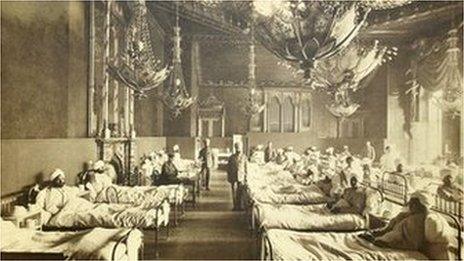Brighton Pavilion wreath ceremony remembers Indian troops
- Published

The soldiers were treated in the grandiose surroundings of the Royal Pavilion
A wreath-laying ceremony has been held to commemorate Indian soldiers who were treated at hospitals in Brighton during World War One.
The ceremony was at the India Gate at the Royal Pavilion, one of several buildings which became military hospitals during the 1914-1918 war.
The Dome and the Corn Exchange were also used to care for Indian soldiers wounded fighting on the western front.
The Indian High Commissioner Ranjan Mathai was due to be at the ceremony.
The event at 14:00 BST was organised by Brighton and Hove City Council, the Chattri Memorial Group, external and Brighton and Hove Black History, as part of the city's World War One centenary commemorations.
'Dr Brighton'
Soldiers treated at the Royal Pavilion wrote of being "tended like flowers", of "never being so happy" and called the hospital "a fairyland".
Wards and operating theatres were set up under the chandeliers and lavish decorations of the Pavilion.
The India Gate, at the entrance to the Royal Pavilion in Pavilion Gardens, was a gift from India and was unveiled by the Maharaja of Patiala in October 1921.
Mayor of Brighton & Hove, Brian Fitch, said: "The city played an important role as 'Dr Brighton' during World War One and thousands of Indian soldiers were brought here to recover by the sea.
"The wreath laying is a fitting way to honour their memory and the contribution they made in the war, fighting so far away from home."
- Published7 June 2014
